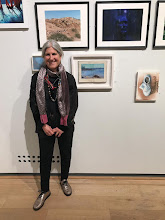A B
Both of these studies are 6"sq. I began study 'a' feeling very rusty about colour studies. My next task (from David Hornung's colour workshop book) was to create a 'free study' and the previous reading was about the use of white and black around colour and the impact on adjacent colour. I thought I'd see what happened with black and white and try to jog my memory around an understanding of colour relations. I used neocolour 2 (water soluble crayons) and portfolio water soluble oil pastels first. They are messy to work with if you are trying for precision. I didn't begin thinking 'this is the plan' I had a loose objective and perhaps choice of materials didn't really suit where I ended up going... but it gave my a chance to think about texture, something I hadn't considered before. The task was to use each colour at least twice. I didn't plan value or hue constraints. I wanted to use a variety of materials. I wanted to add some pattern. Could I have too many variables going on here? In the end I used paper scraps, Caran D'ache gouache, black permanent pen and white paper. Whatever colour I laid down on the square, I put the same colour on another piece of white paper to cut and collage elsewhere.
In the second study I wanted to see what would happen if I seperated the blue/greens from the red/yellows. I was also thinking I was putting the darker value at the top. But as I responded to the image I found I needed a rich, deep more prismatic red/orange. The lemon yellow is quite cool and I put the cobalt violet with the blue greens... so the end result was a wider range of values, a similar range of hues and more black in 'b'. Although much is similar I prefer the gesture in 'b'.
Thursday, April 4, 2013
Considering the role of white and black on colour
Subscribe to:
Post Comments (Atom)






No comments:
Post a Comment